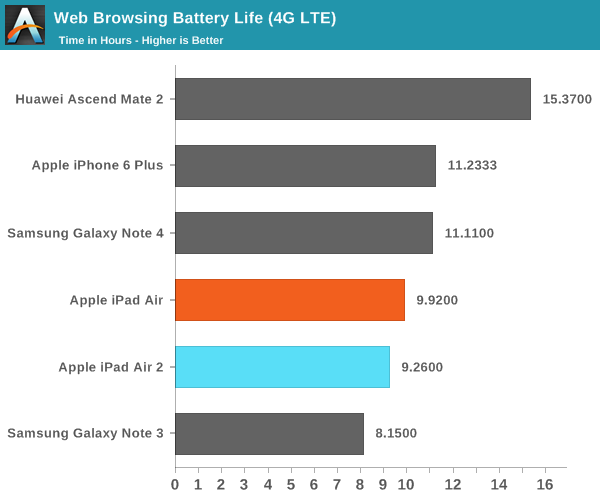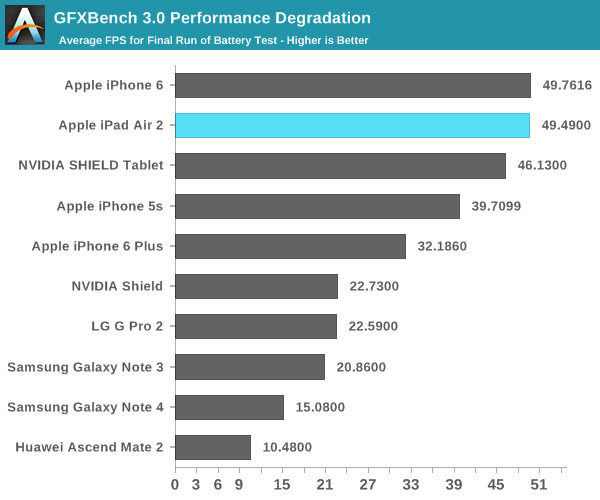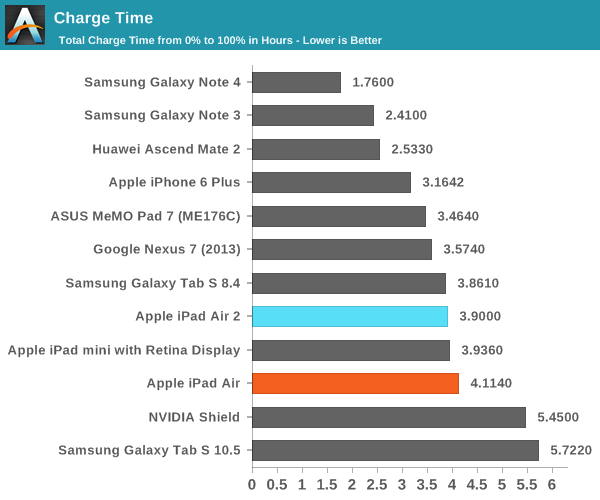The Apple iPad Air 2 Review
by Joshua Ho on November 7, 2014 9:30 AM EST- Posted in
- Tablets
- Apple
- Mobile
- iOS
- ipad Air 2
Battery Life
With the move from featurephones to smartphones, battery life has been and continues to be a critical issue. While it wasn’t unusual to see a week or more of battery life on a featurephone, some of the earliest smartphones couldn’t even last a day. While tablets seem to have a much easier time achieving high levels of battery life by virtue of massively increased volume, they still face similar issues as they are often used for gaming or other more intensive workloads that a smartphone is unlikely to see nearly as often. In order to test this, we run our tablets through a standard suite of tests of various use cases. In all cases where the display is on, all displays are calibrated to a brightness of 200 nits to draw useful relative comparisons.

In our first test, we see that the iPad Air 2 is about roughly equivalent to the original iPad Air for WiFi web browsing. This is actually a bit surprising as the battery in the iPad Air 2 is approximately 84% of the iPad Air. This would mean that we would expect the iPad Air 2 to get around 8.4 hours of battery life in this test, which represents a 16% gain to efficiency. It’s likely that these improvements to battery life come from the new process node on the A8X, along with the newer WiFi module.

Along the same lines, the LTE web browsing test tracks quite closely but it seems that there’s a minor decrease in efficiency gains when compared to WiFi. This difference is likely to be explained by the much higher bandwidth available in WiFi when compared to LTE.
While the web browsing tests are effective at ensuring faster SoCs aren’t punished, this inherently tilts battery life towards a more display-bound mode rather than compute-bound. Unfortunately short of a jailbreak it doesn’t seem possible to get an effective Basemark OS II battery test, so we’re mostly limited to a test of GFXBench’s unlimited rundown.


As one can see, the iPad Air 2 is one of the best performers on this test, considering its frame rate and runtime. While NVIDIA's GK20A GPU in Tegra K1 can get close to the GX6650 for short periods of time, over a long workload it's pretty clear that the GX6650 on 20nm has better sustained performance and significantly superior efficiency as it doesn't throttle until the 200th iteration of the test. It's important to note that the iPad Air 2 is running at a higher native resolution here, so relative to SHIELD Tablet a scaling factor needs to be estimated in order to get an idea for performance at the same resolution. During this test I saw that the skin temperatures never exceeded 45C, so this isn't the result of Apple choosing to run the device hotter than most.
Charge Time
While tablets deliver some great battery life in general, charge time tends to be much slower than that of smartphones as the battery is much larger and charging the device isn't as time critical due to the longer battery life . While we can't quite cover the full range of battery life uses cases, it's important to remember that in cases where the platform is otherwise identical beyond display that battery life scales linearly with overall capacity. In order to test charge time, we measure the time it takes for the battery to reach 100% from a fully-depleted state.

As one can see, the smaller battery seems to have a noticeable impact on charge time, although the difference isn't really all that notable as the difference is only around ten minutes at the end of the day.











226 Comments
View All Comments
kron123456789 - Friday, November 7, 2014 - link
"looks like K1 doesn't support FP16." — well, it really doesn't. K1 has no FP16 ALUs. But it does have a few FP64 ALUs. It's Kepler after all.JoshHo - Friday, November 7, 2014 - link
We have had an ongoing internal debate over how to best represent performance in thermally-limited scenarios. However, the goal of our specific test is to try and show the lower bound for performance although we will include the full FPS graph from here on out.It's certain that the CPU is fully capable of throttling on the iPad Air 2 much more easily, but as far as we can tell GPU-bound workloads are unlikely to throttle on the iPad Air 2 and performs better than Tegra K1 in this area.
lucam - Friday, November 7, 2014 - link
See the Xiami MIpad..and then comment please..tralalalalalala40 - Friday, November 7, 2014 - link
TouchID is for enterprise. No more 10 digit pins every 5 min!KPOM - Friday, November 7, 2014 - link
True. I acquired the Air 2 primarily for this reason. The added performance and updated design are gravy.Georges003 - Friday, November 7, 2014 - link
I noticed the following on all current and previous generations iPad air and iPad mini.On a white screen (for example blank document/note), pushing with one or more finger(s) on the back of the ipad or on the screen itself, displays a dark shadow in the area being pushed.
I have not observed this effect on the iPhone 6, my iPhone 4s and iPad 4.
Did you or anybody else notice this as well?
If yes, how do you feel about it since this without any doubt the result of design compromises for making the device thin and light?
blackcrayon - Friday, November 7, 2014 - link
I can notice this only if i strongly and deliberately press on the device. But I haven't figured out why anyone would or could do that in normal use by mistake. Why would anyone grip the device that hard?Georges003 - Friday, November 7, 2014 - link
I’ve tried to reproduce this effect on a least 8 devices in 2 different stores and it was present on all of them. On some devices you really didn't have to push very hard and on some the only thing you had to do is to pick it up.Typical applications were one would push “harder” on the screen: Ipad used as a music instrument, games, artists using ipad with pressure-sensitive pens, …The question is not why one would press this hard but why do we accept this while iphones, older Ipads and most, but not all, premium tablets of the competition clearly show that touch screen devices can be designed without showing such behaviour.
blackcrayon - Friday, November 7, 2014 - link
Is the Nexus 9 one of your premium tablets of the competition? I hope not...I also doubt you will generate much pressure on the *back* of the device by pushing harder on the screen. Isn't that on the other side? :) I notice you've "tried" to reproduce this effect. I still don't think this is something that's going to happen in normal use. I bet you'll be outraged over the fact you can break one by putting it on your knee and pressing both sides.
Georges003 - Friday, November 7, 2014 - link
The Nexus 9 happens to be a device with a similar behaviour as the iPad Air 1/2 … great OS but, in my opinion, not a "premium" device.Sushisamurai (link) also commented on this review. He mentions “ … with the volume turned up, the iPad would reverberate/vibrate due to the audio output …” I have also noticed this annoying behaviour and wouldn’t be surprised that this is another consequence of making the iPad Air 2 a little too thin and light.